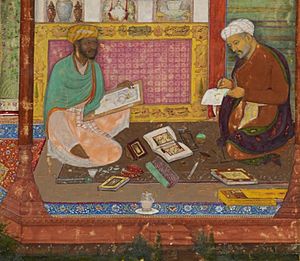Diwan (poetry) facts for kids

A Diwan is a special collection of poems. These poems were often written and gathered in the royal courts of different sultanates. Diwans were very famous for their ability to inspire people. They hold a significant place in the history of literature, especially in the Middle East and South Asia.
Contents
What is a Diwan?
A Diwan is like a book filled with poems by one poet. Sometimes, it can be a collection of poems by several poets. The word "Diwan" comes from the Persian language. It means a "register" or "collection." These collections usually follow a specific order. Poems are often arranged by the last letter of their rhymes.
The Structure of a Diwan
Most Diwans contain different types of poems. The most common type is the ghazal. A ghazal is a short poem with rhyming couplets. Other forms include qasidas (longer, formal odes) and rubaiyat (quatrains). The poet's name or pen name often appears in the last couplet of each ghazal. This was a way for poets to "sign" their work.
History of Diwans
Diwans became popular many centuries ago. They first appeared in the Abbasid era, around the 8th to 13th centuries. This was a time when arts and sciences flourished. Poets were highly respected in royal courts. They would write poems for rulers and for the public.
Spread Across Cultures
The tradition of Diwans spread widely. It moved from Arab lands to Persia, Ottoman Turkey, and Mughal India. Each culture added its own style and themes. Diwans became a key part of Islamic literary traditions. They influenced many languages, including Arabic, Persian, Turkish, and Urdu.
Famous Diwan Poets
Many great poets are known for their Diwans. Their works are still read and loved today.
Hafiz
One of the most famous is Hafiz. He was a Persian poet from the 14th century. His Diwan is called Divan of Hafiz. It is full of beautiful ghazals. These poems often talk about love, wine, and spiritual journeys. Many people in Iran can recite his poems by heart.
Fuzuli
Fuzûlî was another important Diwan poet. He lived in the 15th and 16th centuries. Fuzuli wrote in Azerbaijani, Persian, and Arabic. His poems are known for their deep emotions. They often explore themes of love and suffering.
Baki
Bâkî was a leading Ottoman Turkish poet. He lived in the 16th century. Baki was known for his elegant language. His Diwan shows the beauty of Ottoman court poetry. He was a favorite of Sultan Suleiman the Magnificent.
The Importance of Diwans
Diwans are more than just collections of poems. They are important historical and cultural treasures.
Cultural Impact
Diwans helped shape the literature of many regions. They preserved stories, ideas, and feelings from different eras. They were often beautifully decorated. Many Diwans are works of art themselves. They show the skill of calligraphers and illuminators.
Educational Value
These collections also served an educational purpose. They taught moral lessons and philosophical ideas. People would study Diwans to learn about language, history, and wisdom. They continue to be studied in schools and universities today.
How Diwans Were Made
Creating a Diwan was a careful process. Scribes would collect a poet's works. They would then arrange them in a specific order. Often, the poems were written by hand. They were then bound into beautiful books. These books were sometimes given as gifts to rulers. They were also kept in royal libraries.
Images for kids
-
Fuzûlî (1483?–1556), Divan poet of Azeri origin
See also
 In Spanish: Diván (poesía) para niños
In Spanish: Diván (poesía) para niños




